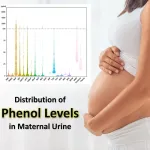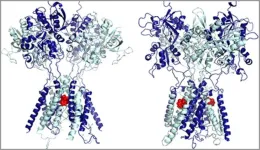High exposure to everyday chemicals linked to asthma risk in children
A groundbreaking study from Kumamoto University
2024-11-19
(Press-News.org)
A new study from researchers at Kumamoto University sheds light on a potential link between exposure to certain everyday chemicals during pregnancy and the development of asthma in children. The study analyzed data from over 3,500 mother-child pairs as part of the Japan Environment and Children’s Study (JECS), a large-scale nationwide research project.
Key Findings:
High levels of butylparaben, a chemical commonly used in personal care products like lotions and shampoos, during early pregnancy were associated with a 1.54-fold increase in the odds of asthma development in children (Odds Ratio: 1.54).
Exposure to 4-nonylphenol, a chemical found in some cleaning products and plastics, showed a striking gender-specific effect. Boys born to mothers exposed to this chemical had 2.09 times higher odds of developing asthma, while no such association was observed in girls.
What Are Phenols? Phenols, including parabens and alkylphenols, are widely used in consumer products for their preservative and antimicrobial properties. While their use is considered safe in small amounts, their potential as endocrine disruptors raises concerns about long-term health effects, such as the recent increase in allergenic diseases such as asthma, particularly during sensitive periods like pregnancy.
The Study: Led by Dr. Shohei Kuraoka and his team at Southern Kyushu and Okinawa Unit Center of Japan Environment and Children’s Study, researchers measured 24 types of phenols in urine samples collected from pregnant women. They then tracked the health of their children until the age of four. The findings highlight the importance of understanding how everyday chemical exposures might contribute to respiratory and allergic conditions in children.
Implications for Public Health: “These results emphasize the need for careful evaluation of chemical exposure during pregnancy,” said Dr. Kuraoka. “Understanding these risks allows us to develop better guidelines to protect maternal and child health.”
While the study provides groundbreaking insights, the researchers acknowledge limitations, such as not measuring phenol levels in children directly. Future studies will aim to explore these mechanisms further and establish safe exposure thresholds.
A new study from researchers at Kumamoto University sheds light on a potential link between exposure to certain everyday chemicals during pregnancy and the development of asthma in children. The study analyzed data from over 3,500 mother-child pairs as part of the Japan Environment and Children’s Study (JECS), a large-scale nationwide research project.
Key Findings:
High levels of butylparaben, a chemical commonly used in personal care products like lotions and shampoos, during early pregnancy were associated with a 1.54-fold increase in the odds of asthma development in children (Odds Ratio: 1.54).
Exposure to 4-nonylphenol, a chemical found in some cleaning products and plastics, showed a striking gender-specific effect. Boys born to mothers exposed to this chemical had 2.09 times higher odds of developing asthma, while no such association was observed in girls.
What Are Phenols? Phenols, including parabens and alkylphenols, are widely used in consumer products for their preservative and antimicrobial properties. While their use is considered safe in small amounts, their potential as endocrine disruptors raises concerns about long-term health effects, such as the recent increase in allergenic diseases such as asthma, particularly during sensitive periods like pregnancy.
The Study: Led by Dr. Shohei Kuraoka and his team at Southern Kyushu and Okinawa Unit Center of Japan Environment and Children’s Study, researchers measured 24 types of phenols in urine samples collected from pregnant women. They then tracked the health of their children until the age of four. The findings highlight the importance of understanding how everyday chemical exposures might contribute to respiratory and allergic conditions in children.
Implications for Public Health: “These results emphasize the need for careful evaluation of chemical exposure during pregnancy,” said Dr. Kuraoka. “Understanding these risks allows us to develop better guidelines to protect maternal and child health.”
While the study provides groundbreaking insights, the researchers acknowledge limitations, such as not measuring phenol levels in children directly. Future studies will aim to explore these mechanisms further and establish safe exposure thresholds.
END
[Attachments] See images for this press release:

ELSE PRESS RELEASES FROM THIS DATE:
2024-11-19
Transparency and effective communication are critical for brands to gain and keep consumer trust according to new research.
The University of Adelaide’s Dr Kate Sansome, from the Adelaide Business School has led a study which suggests that consumers want brands to be transparent about topics that impact them.
“As sociopolitical issues become topical in the news and social media, brands are expected to be transparent about them; for example, as consumers face cost-of-living pressures, they will expect brands to be transparent about this issue,” says Dr Sansome, who conducted the study with the Professor Jodie Conduit and Dr ...
2024-11-19
□ A research team led by Professor Jaedong Lee from the Department of Chemical Physics of DGIST (President Kunwoo Lee) has introduced a novel quantum state and a pioneering mechanism for extracting and controlling quantum information using exciton and Floquet states.
□ Collaborating with Professor Noejung Park from UNIST’s Department of Physics (President Chongrae Park), the team has, for the first time, demonstrated the formation and synthesis process of exciton and Floquet states, which arise from light-matter interactions in two-dimensional semiconductors. This study captures quantum information in real-time as it unfolds through entanglement, offering ...
2024-11-19
Images
Climate change is a persistent and growing challenge to plant life on our planet. Changes to the environment that plants are unaccustomed to affect how they grow, putting much at risk. Increasingly, plant scientists are trying to determine how these environmental changes will impact plant life and whether plants will be able to acclimate to a new status quo.
Researchers from the Walker lab at the Michigan State University-U.S. Department of Energy Plant Research Laboratory, or PRL, are looking at how paper birch trees adapt to changing environments based on how they manage a vital plant process called photorespiration.
“If ...
2024-11-19
Over 14 million tonnes of microplastics are estimated to be lying on the ocean floor with the fashion industry among the worst pollutants.
But a new project led by textile experts at Heriot-Watt University in the Scottish Borders, is aiming to make fashion labels and consumers alike, more environmentally aware when manufacturing and buying new clothes.
For four years, a small team headed by Dr Lisa Macintyre, associate professor of textiles at the University’s School of Textiles and Design in the Galashiels campus, has overseen painstaking ...
2024-11-19
Working paper | Quantitative data analysis | People
Truancy rates have risen faster in developed English-speaking countries since the Covid-19 pandemic than in non-English-speaking countries, according to a new working paper by UCL researchers.
Teenage girls are also increasingly more likely to skip school than boys across Anglophone countries.
In 2022, 26% of all Year 11 pupils in England reported playing truant at least once in the last fortnight. This represented an increase from 2012 and 2018, the previous data capture points, when the figure was at 18% each time.
In the same year (2022), 29% of Year 11 girls in England reported skipping school in the past ...
2024-11-18
LA JOLLA (November 14, 2024)—Excess cholesterol is known to form artery-clogging plaques that can lead to stroke, arterial disease, heart attack, and more, making it the focus of many heart health campaigns. Fortunately, this attention to cholesterol has prompted the development of cholesterol-lowering drugs called statins and lifestyle interventions like dietary and exercise regimens. But what if there’s more to the picture than just cholesterol?
New research from Salk Institute scientists describes how another class of lipids, called sphingolipids, contributes to arterial plaques and atherosclerotic cardiovascular disease ...
2024-11-18
BUFFALO, N.Y. — University at Buffalo neuroscientists have identified the binding site of low-dose ketamine, providing critical insight into how the medication, often described as a wonder drug, alleviates symptoms of major depression in as little as a few hours with effects lasting for several days.
Published in September in Molecular Psychiatry, the UB discovery will also help scientists identify how depression originates in the brain, and will stimulate research into using ketamine and ketamine-like drugs for other ...
2024-11-18
As whooping cough cases rise in the U.S., a new nasal vaccine developed by Tulane University may hold the key to reducing the spread of the highly contagious respiratory disease.
Current pertussis vaccines are widely used and effective at preventing whooping cough, caused by the Bordetella pertussis bacteria. However, the vaccines fail to clear bacteria from the upper respiratory tract, allowing even vaccinated individuals to spread the disease.
The new vaccine combines the traditional pertussis antigens with an innovative ...
2024-11-18
Image
Highlights:
MSU researchers now can identify more proteins, or biomarkers, in blood plasma, including those linked to specific diseases like cancer.
By identifying these biomarkers earlier, medical researchers can create better diagnostic tests and drugs that target diseases sooner, improving patient outcomes.
EAST LANSING, Mich. – Medical professionals have long known that the earlier a disease is detected, the higher the chance for a better patient outcome. Now, a multidisciplinary team of Michigan State University researchers, in ...
2024-11-18
Artificial intelligence is making impressive strides in its ability to read medical images. In a recent test in Britain's National Health Service, an AI tool looked at the mammograms of over 10,000 women and correctly identified which patients were found to have cancer. The AI also caught 11 cases doctors had missed. But systemic diseases, such as lupus and diabetes, present a greater challenge for these systems, since diagnosis often involves many kinds of medical images, from MRIs to CT scans.
Sheng Wang, a University ...
LAST 30 PRESS RELEASES:
[Press-News.org] High exposure to everyday chemicals linked to asthma risk in children
A groundbreaking study from Kumamoto University



